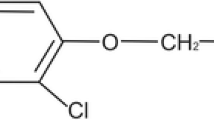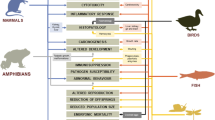Abstract
The compounds 2,4-dicholorophenoxy acetic acid (2,4-D) and 2,4,5-trichlorophenoxy acetic acid (2,4,5-T) and their salts are among the most commonly recognized herbicides. These compounds and their salts and esters have long been used for control of broad leaf weeds and woody plants in which they exert a herbicidal action by acting on plant growth hormones. It is not known that they exert any hormonal action in animals, but their mechanisms of mammalian toxicity is still poorly understood. These compounds’ toxicities have been comprehensively reviewed. (IARC, 1977; Hayes, 1982; IPCS, 1984; Crump, 1986).
Access this chapter
Tax calculation will be finalised at checkout
Purchases are for personal use only
Preview
Unable to display preview. Download preview PDF.
Similar content being viewed by others
References
Balarajan, R., and Acheson, E.D. Soft tissue sarcomas in agriculture and forest workers. J Epi and Comm Hlth 38:113–116, (1984).
Bauer, H., Shulz, K.H., and Spiegelberg, U. Berufliche vergif thingen bei der herstellung von chlorphenol-verbindungen. Arch Gewerbepathol Gewerbehyg 18:538–555, (1961).
Berkeley, M., and Magee, K. Neuropathy following exposure to a dimethyline salt of 2,4-D. Arch Int Med 111:351–353, (1963).
Berwick, P. 2,4-Dichlorophenoxyacetic acid poisoning in man. J Amer Med Assoc 214:1114–117, (1970).
Blakeley, B.R., and Shiefer, B.H. The Effect of Topically Applied n-butylester of 2,4-Dichlorphenoxyacetic Acid on the Immune Response in Mice, J Appl Toxicol 6:291–295, (1986).
Bucher, N.L.R. Effects of 2,4-dichlorophenoxyacetic acid on experimental animals. Proc. Soc. Exp. Biol. Med. 63, 204–205, (1946).
Cantor, K.P. Farming and mortality from non-Hodgkins lymphoma: a case control study. Int J Cancer 29:239–242, (1982).
Courtney, K.D., and Moore, J.A. Teratology studies with 2,4,5-trichlorophenoxyacetic acid and 2,3,7,8-tetrachlorodibenzo-p-dioxin. Toxicol Appl Pharmacol 20:395–403, (1971).
Crump, K.S., and Co. Inc. Worst-Case Analysis Study on Forest Plantation Herbicide Use. Prepared for Forest Land Management Division, Department of Natural Resources, State of Washington, May 1986, (1986).
Desi, I., Sos, J., Sule, F., and Markus, V. Nervous system effects of a chemical herbicide. Arch Environ Health 4:101–108, (1962).
Donovan, J.W., Adena, M.A., Rose, G., and Battistutta, D. Case-Control Study of Congenital Anomalies and Vietnam Service (Birth Defects Study). Australian Government PublishingService, Canberra, 127pp, (1983).
Elo, H.A., and Ylitalo, P. Distribution of 2-methyl-4-chlorophenoxyacetic acid and 2, 4-dichlorophenoxyacetic acid in male rats: Evidence for the involvement of the central nervous system in their toxicity. Toxicol Appl Pharmocol 51:439–44, (1979).
Erickson, J.D., Mulinare, J., McClain, P.W., Fitch, T.G., James, L.M., McClearn, A.B., and Adams, M.J. Jr. Vietnam Veterans’ Risk for Fathering Babies with Birth Defects. U. S. Deptartment of Health and Human Services, CDC Center for Environmental Health, Atlanta, GA. August 1984, 370 pp, (1984).
Gehring, P.J., Kramer, C.G., Schwetz, B.A., Rose, J.Q., and Rowe, V.K. The Fate of 2,4,5-trichlorophenoxyacetic acid (2,4,5-T) following oral administration to man. Toxicol Appl Pharmacol 26:352–361, (1973).
Goldman, P.J. Schwerste akute Chloracne durch Trichlorophenol-zersetzungsprodukte. Arbeitsmed. Sozialmed. Arbeitshyg. 7, 12–18, (1972).
Goldstein, N., Jones, P., and Brown, J. Peripheral neuropathy after exposure to an ester of dichlorophenoxy acitic acid. J Amer Med Assoc 171:1306–1309, (1959).
Hamify, J.A., Metcalf, P., Nobbs, C.L., and Worsley, K.J. Aerial spraying of 2,4,5-T and human birth malformations: an epidemiological investigation. Science 212:349–351, (1981).
Hardell, L., Eriksson, M., Lenner, P., and Lundgren, E. Malignant lymphoma and exposure to chemicals, especially organic solvents, chlorophenols, and phenoxy acids: a case control study. Br J Cancer 43:169–176, (1981).
Hardell, L., and Sandstrom, A. Case-control study: soft-tissue sarcomas and exposure to phenoxyacetic acids or chlorophenols. Br J Cancer 39:711–717, (1979). MD, pp. 520–536, (1982).
Hayes, W.J. Jr., Herbicides, Chapter 11 in Pesticides Studied in Man. Williams & Wilkins, Baltimore, pp. 520–536. (1982).
Hill, E.V. and Carlisle, H. Toxicity of 2, 4-dichlorophenoxyacetic acid for experimental animals. J Ind Hyg Toxicol 29:85–95, (1947).
Hoar, S.K., Blair, A., Holmes, F.F., Boysen, C.D., Rohel, R. R., Hoover, R., and Fraumeni, J.F. Agricultural herbicide use and risk of lymphoma and soft-tissue sarcoma. J Amer Med Assn, pp. 256, 1141–1147, (1986).
Hoffman, R.E., Stehr-Green, P.A., Webb, K.B., Evans, R.G., Knutsen, A.P., Schramm, W. F., Stoake, J.L., Gibson, B.B., and Steinberg, K.K. Health effects of long-term exposure to 2, 3, 7, 8-tetrachlorodibenzo-p-dioxin. J Amer Med Assn, 255:2031–2038, (1986).
Hornberger, E., Reggiani, G., Sambeth, J., and Wipf, H.K. The seveso accident: its nature, extent and consequences. Ann Occup Hyg 22:327–367, (1979).
IPCS. 2. 4-Dichlorophenoxacetic acid (2. 4-D). Environmental Health Criteria 29. International Program on Chemical Safety (IPCS). World Health Organization, Geneva, Switzerland, 151 pp. (1984).
IARC. Some Fumigants, the Herbicides 2,4-P and 2,4,5-T, Chlorinated Dibenzodioxins, and Miscellaneous Industrial Chemicals. IARC monograph on the evaluation of the carcinogenic risk of chemicals to man. Volume 15. International Agency for Research on Cancer. Lyon, France, 354pp, (1977).
Khera, K.S. and McKinley, W.P. Pre- and postnatal studies on 2, 4,5-trichlorophenoxyacetic acid, 2,4-dichlorophenoxyacetic and their derivatives in rats. Toxicol Appl Pharmacol 22:14–18, (1972).
Lamb, J.C., IV, Moore, J. A., Marks, T.A., etal. Development and viability of offspring of male mice treated with chlorinated phenoxy acids and 2,3,7,8-tetrachlorodibenzo-p-dioxin. J Toxicol Environ Health 8:835–844, (1981).
Murphy, S.D. The toxicity of pesticides and their metabolites in Degradation of Synthetic Organic Molecules in the Biosphere. Proceedings of a Conference of the National Academy of Sciences. NAS Press, Washington, D.C. pp 313–335, (1972).
Panel on Herbicides. Report on 2.4.5-T: A report of The Panel on Herbicides of the President’s Science Advisory Committee. Executive Office of the President, Office of Science and Technology, U.S. Government Printing Office, Washington, D.C., (1971).
Pazderova-Vijlupkova, J., Nemcova, M., Pickova, J., Jiresek, L., and Lukas, E. The development and prognosis of chronic intoxication by tetrachlorodibenzo-p-dioxin in men. Arch Environ Health 36:5–11, (1981).
Piper, W.N., Rose, J.Q., Leng, M.L., and Gehring, PJ. The fate of 2,4,5-trichlorophenoxyacetic acid (2,4,5-T) following oral administration to rats and dogs. Toxicol Appl Pharmacol 26:339–351, (1973).
Pearce, N.E., Smith, A.H., and Fisher, D.O. Malignant lymphoma and multiple myeloma linked with agricultural applications in a New Zealand cancer registry-based study. Amer J Epidemiol 121:225–236, (1985).
Poland, A.P., Smith, D., Metter, G., and Possick, P. A health survey of workers in a 2, 4-D and 2,4,5-T plant with special attention to chloracne, porphyria cutanea tarda, and psychologic parameters. Arch Environ Health 22:316–327, (1971).
Schwetz, B.A., Sparschu, G.L., and Gehring, PJ. The effect of 2, 4-dichlorophenoxyacetic acid (2,4-D) and esters of 2,4-D on rat embryonal, fetal and neonatal growth and development Food Cosmet Toxicol 9:801–817, (1971).
Singer, R., Moses, M., Valcirskas, J., Luis, R., and Selikoff, I.J. Nerve conduction velocity studies of workers employed in the manufacture of phenoxy herbicides. Environ Res 29:297–311, (1982).
Suskind, R.R. Reports on Clinical and Environmental Surveys. Monsanto Chemical Co., Nitro, West Virginia. Department of Environmental Health, University of Cincinnati College of Medicine (1953).
Todd, R. A case study of 2,4-D intoxication. J Iowa Med Soc 52:663–664, (1962).
Vos, J.G., Krajnc, E.I., Beekhof, P.K., and van Logten, M.J. Methods for testing immune effects of toxic chemicals: evaluation of immunotoxicity of various pesticides in the rat Miyamoto, J., and Kearney, P.C., eds. Pesticide Chemistry. Human Welfare and the Environment. Vol. 3. Mode of Action. Metabolism and Toxicology. Pergamon Press, Oxford, pp497–504, (1983).
Vos, J.G., Moore, L.A., Zinkl, J.G., Toxicity of 2,3,7,8-tetrachlorodibenzo-p-dioxin (TCDD) in C57 B1/6 mice. Toxicol Appl Pharmacol 29:229–241, (1974).
Wallis, W.E., vanPoznak, A., and Plum, F. Generalized muscle stiffness, fasciculations, and myokymia of peripheral nerve origin. Arch Neurol 22:430–439, (1970).
Way, J.M. Toxicity and hazards to man, domestic animals, and wildlife from some commonly used auxin herbicides. Residue Rev. 26:37–62, (1969).
Woods, J.S., Polissar, L., Severson, R.K., and Heuser, M.A. Soft tissue sarcoma and non-Hodgkins lymphoma in relation to phenoxy herbicide and chorinated phenol exposure in Western Washington. J Nat Cancer Inst, in press. (1987).
Author information
Authors and Affiliations
Editor information
Editors and Affiliations
Rights and permissions
Copyright information
© 1987 Springer-Verlag Berlin Heidelberg
About this paper
Cite this paper
Murphy, S.D. (1987). Toxicology of Chlorophenoxy Herbicides and Their Contaminants. In: Costa, L.G., Galli, C.L., Murphy, S.D. (eds) Toxicology of Pesticides. NATO ASI Series, vol 13. Springer, Berlin, Heidelberg. https://doi.org/10.1007/978-3-642-70898-5_5
Download citation
DOI: https://doi.org/10.1007/978-3-642-70898-5_5
Publisher Name: Springer, Berlin, Heidelberg
Print ISBN: 978-3-642-70900-5
Online ISBN: 978-3-642-70898-5
eBook Packages: Springer Book Archive




